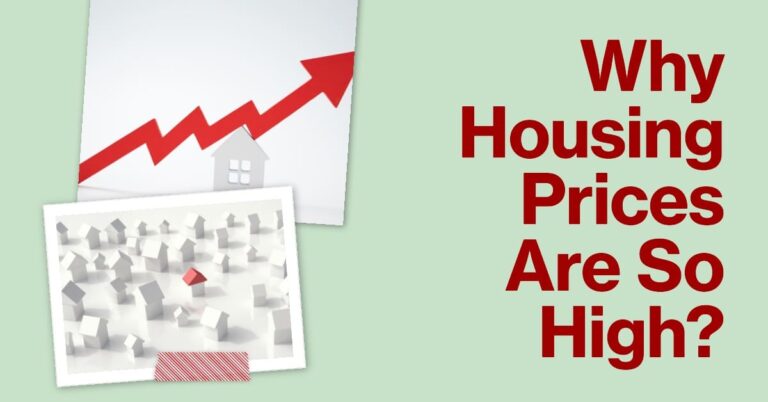If you are looking for a home in the US, you may have noticed that the prices are skyrocketing. The nationwide median sale price of existing-home is now $407,100 (August 2023), just a few thousand dollars short of the all-time high. Meanwhile, the supply of homes for sale is shrinking, making the competition among buyers fierce. Some buyers are offering cash or tens of thousands of dollars over the asking price to secure a deal.
Inventory in August stood at a 3.3-month supply, a level considered a seller’s market. What is driving this housing boom? And is there any relief in sight for aspiring homeowners? In this blog post, we will explore some of the factors that explain why housing prices are so high in the US and what can be done to address the affordability crisis.
Reasons Why Housing Prices Are So High
Demand vs Supply
The simple explanation for why housing prices are so high is that more people want to buy homes, but there aren’t enough on the market. There are several causes of this imbalance, such as:
- The Covid-19 pandemic: The pandemic triggered a wave of migration from densely populated cities to less costly suburban and rural areas, as people sought more space and comfort while working from home. The pandemic also discouraged some homeowners from selling their homes, fearing exposure to the virus or uncertainty about the economy.
- Low interest rates: The Federal Reserve slashed interest rates to near zero in response to the pandemic, making borrowing cheaper and more attractive for homebuyers. Low interest rates also increased the demand for refinancing, which reduced the number of homes available for sale.
- Changing demographics: Millennials, the largest generation in US history, are entering their prime homebuying age and forming households at a faster rate than previous generations. They are also more likely to have higher incomes and savings than their parents, thanks to higher education levels and delayed marriage and childbearing.
- Limited supply: The US has been underbuilding homes for more than a decade, since the housing bubble burst in 2008. According to Freddie Mac, the US is short 3.8 million homes as of 2021. The main reasons for the low supply are higher construction costs, stricter zoning regulations, lower builder confidence, higher land prices and government subsidies that favor renting over owning.
The Impact of High Housing Prices
The high housing prices have significant implications for the economy and society. Some of the impacts are:
- Reduced affordability: High housing prices make it harder for many Americans to afford a home or rent a decent place. According to Harvard University’s Joint Center for Housing Studies, nearly half of all renters and one-third of all homeowners were cost-burdened in 2020, meaning they spent more than 30% of their income on housing. This leaves less money for other essential needs, such as food, health care and education.
- Increased inequality: High housing prices widen the wealth gap between homeowners and renters, as well as between different regions and races. Homeowners benefit from rising home equity and tax advantages, while renters face rising rents and insecurity. Moreover, some areas, especially coastal cities, have seen much faster appreciation than others, creating disparities in opportunities and access to services. Additionally, racial minorities face more barriers to homeownership, such as discrimination, lower incomes and less access to credit.
- Decreased mobility: High housing prices reduce the ability of people to move to areas with better jobs, schools and amenities. This limits their economic prospects and social networks. It also reduces the efficiency of the labor market, as employers have difficulty attracting and retaining workers in high-cost areas.
What Can Be Done to Lower Housing Prices?
There is no easy or quick solution to lower housing prices in the US. However, some possible steps that could help are:
- Increase supply: The most obvious way to lower housing prices is to build more homes, especially affordable ones. This would require easing zoning restrictions, streamlining permitting processes, providing incentives and subsidies for developers, expanding infrastructure and public services, and encouraging innovation and sustainability in construction methods and materials.
- Reduce demand: Another way to lower housing prices is to reduce the demand for homes, especially from speculative investors or foreign buyers who drive up prices and crowd out local residents. This could involve imposing taxes or fees on vacant or second homes, tightening lending standards or increasing interest rates.
- Expand assistance: A third way to lower housing prices is to expand assistance for low-income and moderate-income households who struggle to afford housing. This could include increasing rental vouchers, expanding tax credits, providing down payment assistance or creating shared equity programs.
To summarize, housing prices are so high in the US because of a combination of factors that have created a mismatch between demand and supply. This has resulted in reduced affordability, increased inequality and decreased mobility for many Americans. To address this challenge, policymakers, developers, lenders and consumers need to work together to increase supply, reduce demand and expand assistance for those who need it most.





